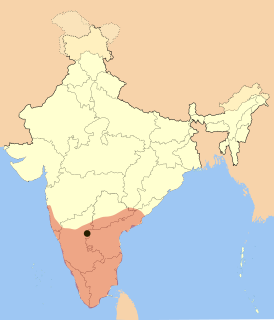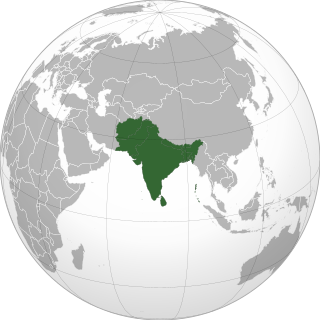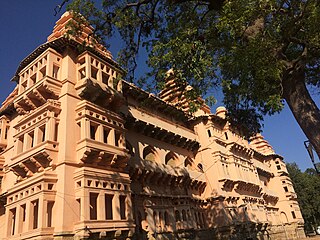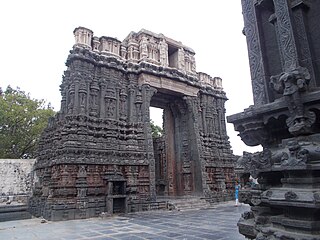Kamma is a Hindu caste from South India. The community of Kammas is believed to have originated from agriculturists of the Kammanadu region of the Guntur and Prakasam districts in Andhra Pradesh. Propelled by their military activity in the Vijayanagara Empire, Kammas are believed to have spread out from the region during the Vijayanagara period, followed by some in-migration during the British period and out-migration again during the twentieth century. Today they are regarded as the richest group in Andhra Pradesh and are a dominant caste from Coastal Andhra with socio-economic and political prominence throughout the Telugu-speaking regions of India.

The Vijayanagara Empire was based in the Deccan Plateau region in South India. It was established in 1336 by the brothers Harihara I and Bukka Raya I of the Sangama dynasty, members of a pastoralist cowherd community that claimed Yadava lineage. The empire rose to prominence as a culmination of attempts by the southern powers to ward off Islamic invasions by the end of the 13th century. At its peak it had subjugated almost all of South India's ruling families and the Sultans of the Deccan region, thus becoming a notable power. It lasted until 1646, although its power declined after a major military defeat in the Battle of Talikota in 1565 by the combined armies of the Deccan sultanates. The empire is named after its capital city of Vijayanagara, whose ruins surround present day Hampi, now a World Heritage Site in Karnataka, India. The writings of medieval European travelers such as Domingo Paes, Fernão Nunes, and Niccolò Da Conti, and the literature in local languages provide crucial information about its history. Archaeological excavations at Vijayanagara have revealed the empire's power and wealth.

The history of southern India covers a span of over four thousand years during which the region saw the rise and fall of a number of dynasties and empires. The period of known history of the region begins with the Iron Age period until the 14th century CE. Dynasties of Chera, Chola, Pandyan, Chalukya, Pallava, Satavahana Rashtrakuta, Kakatiya, Seuna (Yadava) dynasty and Hoysala were at their peak during various periods of history. These Dynasties constantly fought amongst each other and against external forces when northern armies invaded southern India. Vijayanagara empire rose in response to the Muslim intervention and covered the most of southern India and acted as a bulwark against Mughal expansion into the south. When the European powers arrived during the 16th and 18th century CE, the southern kingdoms, most notably Tipu Sultan's Kingdom of Mysore, resisted the new threats, and many parts eventually succumbed to British occupation. The British created the Madras Presidency which acted as an administrative centre for the rest of South India, with them being princely states. After Indian independence South India was linguistically divided into the states of Tamil Nadu, Andhra Pradesh, Karnataka, Telangana and Kerala.

Krishnadevaraya was an emperor of the Vijayanagara Empire who reigned from 1509–1529. He was the third ruler of the Tuluva Dynasty and is considered to be its greatest ruler. He possessed the largest empire in India after the decline of the Delhi Sultanate. Presiding over the empire at its zenith, he is regarded as an icon by many Indians. Krishnadevaraya earned the titles Kannada Rajya Rama Ramana, Andhra Bhoja and Mooru Rayara Ganda. He became the dominant ruler of the peninsula of India by defeating the Sultans of Bijapur, Golconda, the Bahmani Sultanate and the Gajapatis of Odisha, and was one of the most powerful Hindu rulers in India. Indeed, when the Mughal Emperor Babur was taking stock of the potentates of north India, Krishnadevaraya was rated the most powerful and had the most extensive empire in the subcontinent.
Reddy is a caste that originated in India, predominantly settled in Andhra Pradesh and Telangana. They are classified as a forward caste.
Rama Raya, known as "Aliya" and "Mahamandalesvara Alludu" (Telugu), was a Telugu statesman of the Vijayanagara Empire, the son-in-law of Emperor Krishna Deva Raya and the progenitor of the Aravidu dynasty of Vijayanagar Empire, the fourth and last dynasty of the empire.

The Reddi kingdom or Kondavidu Reddi kingdom was established in southern India by Prolaya Vema Reddi. The region that was ruled by the Reddi dynasty is now part of modern-day coastal and central Andhra Pradesh. Prolaya Vema Reddi was part of the confederation that started a movement against the invading Turkic armies of the Delhi Sultanate in 1323 and succeeded in repulsing them from Warangal.

The Thanjavur Nayak kingdom or Thanjavur Nayak dynasty were the Telugu rulers of Thanjavur principality of Tamil Nadu in the 16th and 17th centuries. The Nayaks of the Balija social group, were originally appointed as provincial governors by the Vijayanagara Emperor in the 15th century, who divided the Tamil country into three Nayakships viz., Madurai, Tanjore and Gingee. In the mid 16th century they became an independent kingdom, although they continued their alliance with the Vijayanagara Empire. The Thanjavur Nayaks were notable for their patronage of literature and the arts.
Balija is a caste of the Indian states of Andhra Pradesh, Tamil Nadu, Karnataka, and Kerala.

Gandikota is a village and historical fort on the right bank of the Penna river, 15 km from Jammalamadugu in Kadapa district, Andhra Pradesh, India. The fort was the center of power for various dynasties, such as the Kalyani Chalukyas, Pemmasani Nayakas, and the Golconda Sultanate. Gandikota was the capital of Pemmasani Nayakas for more than 300 years. Pemmasani Ramalinga Nayaka constructed the huge fort at Gandikota with 101 towers replacing the previous sand fort constructed by Kaka Raja, Vassals of Kalyani Chalukya rulers. Various additions of Islamic architecture were made during subsequent Muslim rule.
The origin of Vijayanagara empire is a controversial topic in South Indian history, with regard to the linguistic affiliation of the founding dynasty, the Sangama family. The Vijayanagara Empire rose to power in southern India in the 14th century CE. Over the past decades historians have expressed differing opinions on whether the empire's founders, Harihara I and Bukka I, were of Kannada or Telugu origin. There are various opinions about role of the Vidyaranya, the Hindu saint and guru of Harihara I and Bukka I in the founding of the Vijayanagara empire.
Pemmasani Nayaks were a ruling clan in the south Indian state of Andhra Pradesh. They came into prominence during Vijayanagara times as rulers of Gandikota over 300 years. After the Battle of Talikota in 1565 AD, the collapse of Vijayanagara Empire led to the emergence of Pemmasani Nayakas in the Rayalaseema region who protected Hindu dharma for more than 100 years up to 1685 AD. Pemmasani Kings helped Aravidu dynasty Kings in battles with Muslim kings to protect Hindu religion in South India.

Venkata III was the grandson of Aliya Rama Raya. Venkata III belonged to the Telugu Family and became the King of Vijayanagara Empire from 1632–1642. His brothers in law were Damarla Venkatappa Nayaka and Damarla Ayyappa Nayaka, both sons of Damarla Chennapa Nayakadu

Andhra Pradesh is one of the 28 states of India whose recorded history begins in the Vedic period. It is mentioned in Sanskrit epics such as Aitareya Brahmana. The Assaka Mahajanapada was an ancient kingdom located between the Godavari and Krishna Rivers in southeastern India.
Pemmasani Ramalinga Nayudu was as a general of the Vijayanagara emperor Krishnadevaraya in the 17th century Telugu text Rayavachakamu, and a later poetic rendition Krishnarajavijayam.

Chandragiri Fort is a historical fort, built in the 11th century located in Chandragiri, Tirupati in Andhra Pradesh, India. Although mostly associated with the Vijayanagara Emperors it was built much earlier in 11th century by the Yadava rulers.

Chintalarayaswamy Temple or Sri Chintala Venkataramana Temple is a Hindu Vaishnavite temple situated at Tadipatri, a town in the Anantapur District of Andhra Pradesh, India. The Temple is dedicated to Lord Venkateswara, a form of Vishnu, who is referred to as Chintala Venkataramana. The temple was built by Pemmasani Timmanayudu II of the Pemmasani Nayaks. It is situated on the bank of the Penna River, which passes through the town. The temple is known for its granite sculptures and is classified as one of the Monuments of National Importance by Archaeological Survey of India (ASI). The temple has a Garuda Mandapa built as chariot with rotating granite wheels, which is similar to the one found in the Vithala Temple of Hampi.

Pemmasani Ramalinga Nayudu I was a member of the Pemmasani Nayak clan in the 15th century Vijayanagara Empire in southern India. He developed the hamlet of Tallapalle, renaming it to Tadipatri upon orders of the Vijayanagara emperor. He built a fort in the town and the Bugga Ramalingeshwara Temple. Another temple to Obaleshwara in Kurnool District is also attributed to him.

Pemmasani Timmanayudu II was a member of the Pemmasani Nayaks. He was the son of Pemmasani Ramalinga I and a contemporary of Vira Narasimharaya and Krishnadevaraya. After the death of his father, Timmanayudu went to inform the Vijayanagara Emperor of the progress made in developing the Rayalaseema region. The emperor was so pleased with what he heard that he made Timmanayudu the commandant of the Gandikota Fort on behalf of Saluva Govindaraja, its governor. Then, Timmanayudu gave control of Yadiki and Tadipatri, which were previously controlled by his ancestors, to a relative and shifted to Gandikota.
Pemmasani Erra Timmanayudu, also known as Pedda Timmanayudu or Yara Timmanayudu, was a member of the Pemmasani Nayaks in the 16th century Vijayanagara Empire in South India. He is credited for the rise of Aliya Rama Raya to the throne of Vijayanagara, and he was the commandant of the Gandikota Fort. His brother was the notable Commander Pemmasani Ramalinga Nayudu.